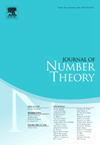Bounds on the number of squares in recurrence sequences: y0 = b2 (I)
IF 0.7
3区 数学
Q3 MATHEMATICS
引用次数: 0
Abstract
We continue and generalise our earlier investigations of the number of squares in binary recurrence sequences. Here we consider sequences, , arising from the solutions of generalised negative Pell equations, , where −c and are any positive squares. We show that there are at most 2 distinct squares larger than an explicit lower bound in such sequences. From this result, we also show that there are at most 5 distinct squares when for infinitely many values of b, including all , as well as once d exceeds an explicit lower bound, without any conditions on the size of such squares.
递归序列中平方数的界限:y0 = b2 (I)
我们继续并推广了先前关于二值递归序列中平方数的研究。这里我们考虑由广义负Pell方程X2 - dY2=c的解引起的序列(yk)k=−∞∞,其中−c和y0是任意正平方。我们证明了在这样的数列中,最多有两个不同的大于显下界的平方。由这个结果,我们还证明了当y0=b2时,当b的无穷多个值,包括所有1≤b≤24,以及当d超过一个显式下界时,不需要对这种正方形的大小有任何条件,最多有5个不同的正方形。
本文章由计算机程序翻译,如有差异,请以英文原文为准。
求助全文
约1分钟内获得全文
求助全文
来源期刊

Journal of Number Theory
数学-数学
CiteScore
1.30
自引率
14.30%
发文量
122
审稿时长
16 weeks
期刊介绍:
The Journal of Number Theory (JNT) features selected research articles that represent the broad spectrum of interest in contemporary number theory and allied areas. A valuable resource for mathematicians, the journal provides an international forum for the publication of original research in this field.
The Journal of Number Theory is encouraging submissions of quality, long articles where most or all of the technical details are included. The journal now considers and welcomes also papers in Computational Number Theory.
Starting in May 2019, JNT will have a new format with 3 sections:
JNT Prime targets (possibly very long with complete proofs) high impact papers. Articles published in this section will be granted 1 year promotional open access.
JNT General Section is for shorter papers. We particularly encourage submission from junior researchers. Every attempt will be made to expedite the review process for such submissions.
Computational JNT . This section aims to provide a forum to disseminate contributions which make significant use of computer calculations to derive novel number theoretic results. There will be an online repository where supplementary codes and data can be stored.
 求助内容:
求助内容: 应助结果提醒方式:
应助结果提醒方式:


